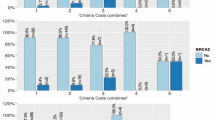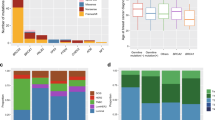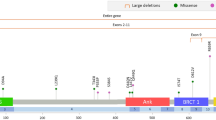Abstract
Breast cancer, one of the most common and deleterious of all diseases affecting women, occurs in hereditary and sporadic forms. Hereditary breast cancers are genetically heterogeneous; susceptibility is variously attributable to germline mutations in the BRCA1 (ref. 1), BRCA2 (ref. 2), TP53 (ref. 3) or ataxia telangiectasia (ATM)4 genes, each of which is considered to be a tumour suppressor. Recently a number of germline mutations in the BRCA2 gene have been identified in families prone to breast cancer5'6. We screened 100 primary breast cancers from Japanese patients for BRCA2 mutations, using PCR-SSCR We found two germline mutations and one somatic mutation in our patient group. One of the germline mutations was an insertion of an Alu element into exon 22, which resulted in alternative splicing that skipped exon 22. The presence of a 64-bp polyadenylate tract and evidence for an 8-bp target-site duplication of the inserted DMA implied that the retrotransposal insertion of a transcrip-tionally active Alu element caused this event. Our results indicate that somatic BRCA2 mutations, like somatic mutations in the BRCA1 gene, are very rare in primary breast cancers.
This is a preview of subscription content, access via your institution
Access options
Subscribe to this journal
Receive 12 print issues and online access
$209.00 per year
only $17.42 per issue
Buy this article
- Purchase on Springer Link
- Instant access to full article PDF
Prices may be subject to local taxes which are calculated during checkout
Similar content being viewed by others
References
Miki, Y. et al. A strong candidate for the breast and ovarian cancer susceptibility gene BRCA1. Science 266, 66–71 (1994).
Wooster, R. et al. Localization of a breast cancer susceptibility gene, BRCA2, to chromosome 13q12–13. Science 265, 2088–2090 (1991).
Malkin, D. et al. Germ line p53 mutations in a familial syndrome of breast cancer, sarcomas, and other neoplasms. Science. 250, 1233–1238 (1990).
Savitsky, K. et al. A single ataxia telangiectasia gene with a product similar to PI-3 kinase. Science 268, 1749–1753 (1995).
Wooster, R. et al. Identification of the breast cancer susceptibility gene BRCA2. Nature 378, 789–792 (1995).
Tavtigian, S.V. et al. The complete BRCA2 gene and mutations in chromosome 13q-linked kindreds. Nature Genet. 12, 333–337 (1996).
Matera, A.G., Hellmann, U. & Schmid, C.W. A Transpositionally and transcriptionally competent Alu subfamily. Mol. Cell. Biol. 10, 5424–5432 (1990).
Batzer, M.A. & Deininger, P.L. RL A human-specific subfamily of Alu sequence. Genomics 9, 481–487 (1991).
Deininger, P.L., Jolly, D.J., Rubin, C.M., Friedman, T. & Schmid, C.W. Base sequence studies of 300 nucleotide renatured repeated human DNA clones. J. Mol. Biol. 151, 17–23 (1981).
Rogers, J. Retroposons defined. Nature 301, 460 (1983).
Deininger, P.L. Mobile DNA, (eds Berg, D.E. & Howe, M.M.) 619–636 (Am. Soc. Microbiol., Washington, 1989).
Vidaud, D. et al. Haemophilia B due to a de novo insertion of a human-specific Alu subfamily member within the coding region of the factor IX gene. Eur. J. Hum. Genet. 1, 30–36 (1993).
Muratani, K. et al. Inactivation of the cholinesterase gene by Alu insertion:possible mechanism for human gene transposition. Proc. Natl. Acad. Sci. USA 88, 11315–11319 (1991).
Mitchell, G.A. et al. Splice-mediated insertion of an Alu sequence inactivates ornithine δ-aminotransferase: A role for Alu elements in human mutation. Proc. Natl. Acad. Sci. USA 88, 815–819 (1991).
Wallace, M.R., Andersen, L.B., Saulino, A.M., Gregory, P.E., Glover, T.W. & Collins, F.S. A de novo Alu insertion results in neurofibromatosis type 1. Nature 353, 864–866 (1991).
Dombroski, B.A., Mathias, S.L., Nanthakumar, E., Scott, A. & Kazazian, H.H., Jr.Isolation of an active human transposable element. Science. 254, 1805–1808 (1991).
Miki, Y. et al. Disruption of the APC gene by a retrotransposal insertion of L1 sequence in a colon cancer. Cancer Res. 52, 643–645 (1992).
Holt, J.T. et al. Growth retardation and tumour inhibition by BRCA1. Nature Genet. 12, 298–302 (1996).
Jensen, R.A. et al. BRCA1 is secreted and exhibits properties of a granin. Nature Genet. 12, 303–308 (1996).
Thompson, M.E., Jensen, R.A., Obermiller, P.S., Page, D.L. & Holt, J.T. Decreased expression of BRCA1 accelerates growth and is often present during sporadic breast cancer progression. Nature Genet. 9, 444–450 (1995).
Chomczynski, P.A. Reagent for the single-step simultaneous isolation of RNA, DNA and proteins from cell and tissue samples. Bio Techniques 15, 532–536 (1993).
Koyama, K., Sudo, K. & Nakamura, Y. Isolation of 115 human chromosome 8 specific expressed sequence tags by exon amplification. Genomics 26, 245–253 (1995).
Author information
Authors and Affiliations
Rights and permissions
About this article
Cite this article
Miki, Y., Katagiri, T., Kasumi, F. et al. Mutation analysis in the BRCA2 gene in primary breast cancers. Nat Genet 13, 245–247 (1996). https://doi.org/10.1038/ng0696-245
Issue Date:
DOI: https://doi.org/10.1038/ng0696-245
This article is cited by
-
More than causing (epi)genomic instability: emerging physiological implications of transposable element modulation
Journal of Biomedical Science (2021)
-
Saw1 localizes to repair sites but is not required for recruitment of Rad10 to repair intermediates bearing short non-homologous 3′ flaps during single-strand annealing in S. cerevisiae
Molecular and Cellular Biochemistry (2016)
-
A reliable method for the detection of BRCA1 and BRCA2 mutations in fixed tumour tissue utilising multiplex PCR-based targeted next generation sequencing
BMC Clinical Pathology (2015)
-
A mutational signature in gastric cancer suggests therapeutic strategies
Nature Communications (2015)
-
An Integrated in Silico Approach to Analyze the Involvement of Single Amino Acid Polymorphisms in FANCD1/BRCA2-PALB2 and FANCD1/BRCA2-RAD51 Complex
Cell Biochemistry and Biophysics (2014)



